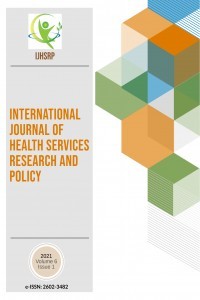EVALUATION OF CLINICAL USE HABİTS OF TUMOR MARKER TESTS
EVALUATION OF CLINICAL USE HABİTS OF TUMOR MARKER TESTS
tumor marker approptiateness, test request,
___
- 1. NIH (National Institutes of Health—National Cancer Institute) 2012, What is cancer, NIH, www.cancer.gov/cancertopics/cancerlibrary/what-is-cancer (accessed 18 December 2012). 2. Sharma S. Tumor markers in clinical practice: General principles and guidelines. Indian J Med Paediatr Oncol. 2009 Jan-Mar; 30(1): 1–8 3. Sturgeon C, Hammond E, Chang SL, Sölétormos G, Hayes DF. NACB: Practice guidelines and recommendations for use of tumor markers in the clinic: Quality requirements [Section 2] 2008 4. Liu J. The dualistic origin of human tumors. Semin Cancer Biol. 2018 Dec; 53: 1–16. 5. Gion M, Peloso L, Trevisiol C, Squarcina E, Zappa M, Fabricio AS. An epidemiology-based model as a tool to monitör the outbreak of inappropiateness in tumor marker requests: a national scale study. Clin Chem Lab Med. 2016; 54(3):473-482 6. Campbell SM, Braspenning J, Hutchinson A, Marshall MN. Research methods used in developing and applying quality indicators in primary care. Qual Saf Health Care. 2002; 11(4): 358-364 7. The Association Of Biochemists in Ireland - Guidelines for the use of tumour markers Fourth edition: October 2010 8. K. Deasy, S. Saadi, F. Ashraf, W. Chin, J. Gilmore, R. Griffiths, E. Ahmed. Are We Ordering Tumor Markers Appropriately? American Journal of Medicine and Medical Sciences 2017, 7(3): 151-155 9. Durand-Zaleski I, Rymer JC, Roudot-Thoroval F, Revuz J, Rosa J. Reducing Unnecessary Laboratory Use With New Test Request Form: Example of Tumor Markers. The Lancet, 1993; 342:150-153 10. Ferraro S, Mozzi R, Panteghini M. Tumor Marker Ordering: Do Not Lose Control: A Prospective Clinical Trial . American Journal of Clinical Pathology, 2015; 144 (4, Pages 649–658
- Yayın Aralığı: Yılda 3 Sayı
- Başlangıç: 2016
- Yayıncı: Rojan GÜMÜŞ
VIOLENCE AGAINST HEALTH WORKERS AND MEASURES TO PREVENT VIOLENCE
Senanur CAN, Çiğdem Müge HAYLI
Samuel TESEMA, Filimona BİSRAT, Tenager TADESSE, Melaku TSEHAY
Abdallah ALWAWİ, Ayşegül KOÇ, Bahar İNKAYA
EFFECT OF EATING ATTITUDES OF INDIVIDUALS WITH TYPE 2 DIABETES UPON QUALITY OF LIFE
THE EFFECT OF TWO DIFFERENT METHODS IN TERMS OF MALPRACTICE: A RANDOMİZED CONTROLLED STUDY
Cagla YIGITBAS, Fadime ÜSTÜNER TOP, Aliye BULUT
EVALUATION OF CLINICAL USE HABİTS OF TUMOR MARKER TESTS
THE EVALUATION OF BURNOUT AND COMMUNICATİON SKILLS IN PRIMARY CARE STAFF
Nilüfer EMRE, Tamer EDİRNE, Aysun ÖZŞAHİN, Ali Rıza TÜRK
HISTOPATHOLOGICAL FINDINGS AND CLINICAL OUTCOMES OF PATIENTS AFTER LAPAROSCOPIC SLEEVE GASTRECTOMY
Muhammed Raşid AYKOTA, Sevda YILMAZ
TOWARD ORGANIZATIONAL EVIDENCE-BASED MANAGEMENT IN HEALTHCARE ORGANIZATIONS
